The Impact of Titanium Hydroxyapatite Doping on the Mechanical and Biological Properties of Photocured Resin
Abstract
:1. Introduction
2. Experimental Section
2.1. Ti-HAp Nanopowder Sample Preparation
2.2. Preparation of the Ti-HAp Photocured Composite Resin
2.3. Characterization of Ti-HAp Nanopowders
2.4. Mechanical Capacity of Ti-HAp Photocured Composite Resin
2.5. Biological Properties of Ti-HAp Photocured Composite Resin
2.6. Statistical Analysis
3. Results and Discussion
3.1. Characterization of Ti-HAp Powder
3.2. The Influence of HAp Doping on the Mechanical Characteristics of Resin
3.3. Effects of Ti-HAp Doping Content on Resin Mechanical Characteristics
3.4. The Biological Properties of Ti-HAp Resin
4. Conclusions
Author Contributions
Funding
Data Availability Statement
Acknowledgments
Conflicts of Interest
References
- Hu, Y.Q.; Deng, H.; Sun, Z.Q. Research Progress in UV-curing Acrylate Resin and Its Applications. Chin. J. Colloid Polym. 2024, 42, 46–50. [Google Scholar] [CrossRef]
- Li, H.J.; Xu, L.; Zhong, W.Z.; Yang, Q.L.; Yang, G.S. Recent Advances of Photocurable 3D Printed Pharmaceutical Preparations. Chin. Pharm. J. 2021, 56, 1189–1195. [Google Scholar] [CrossRef]
- Li, N.; Wang, R.L.; Hou, C.Y.; Liu, M.; Zhang, Q.H. Preparation and Properties of HAp/PMMA Nanocomposite Fiber for Reinforcing Dental Composite Resin. Synth. Fiber China 2020, 49, 36–42. [Google Scholar] [CrossRef]
- Ardestani, S.S.; Bonan, R.F.; Mota, M.F.; da Costa Farias, R.M.; Menezes, R.R.; Bonan, P.R.F.; da Cruz Perez, D.E. Effect of the incorporation of silica blow spun nanofibers containing silver nanoparticles (SiO2/Ag) on the mechanical, physicochemical, and biological properties of a low-viscosity bulk-fill composite resin. Dent. Mater. 2021, 37, 1615–1629. [Google Scholar] [CrossRef] [PubMed]
- Gu, M.; Li, W.; Jiang, L.; Li, X. Recent progress of rare earth doped hydroxyapatite nanoparticles: Luminescence properties, synthesis and biomedical applications. Acta Biomater. 2022, 148, 22–43. [Google Scholar] [CrossRef]
- Pushpalatha, C.; Gayathri, V.S.; Sowmya, S.V.; Augustine, D.; Alamoudi, A.; Zidane, B.; Bhandi, S. Nanohydroxyapatite in dentistry: A comprehensive review. Saudi Dent. J. 2023, 35, 741–752. [Google Scholar] [CrossRef] [PubMed]
- Beuriat, P.A.; Lohkamp, L.N.; Szathmari, A.; Rousselle, C.; Sabatier, I.; Di Rocco, F.; Mottolese, C. Repair of cranial bone defects in children using synthetic hydroxyapatite cranioplasty (CustomBone). World Neurosurg. 2019, 129, e104–e113. [Google Scholar] [CrossRef]
- Song, K.K.; Huang, H.; Lu, M.J.; Yang, C.A.; Weng, J.; Duan, K. Hydrothermal Preparation and Characterization of Zn, Si, Mg, Fe Doped Hydroxyapatite. J. Inorg. Mater. 2021, 36, 1091–1096. [Google Scholar] [CrossRef]
- Liu, Y.; Yang, R.; Liu, J.L.; Liu, J.X.; Zhang, J.L. Hydroxyapatite Nanomaterials Doped with Single-phase, Dual-phase and Multiphase Ions. Surf. Technol. 2022, 51, 143–154. [Google Scholar] [CrossRef]
- Chang, D.B.; Bai, Z.F.; Huang, H.; Yang, A.C.; Li, S.Y.; Weng, J. Morphology and Biological Function of Calcium Phosphate Regulated by Elemental Doping. J. Chin. Ceram. Soc. 2023, 51, 2579–2593. [Google Scholar] [CrossRef]
- Sebastiammal, S.; Fathima, A.S.L.; Alarifi, S.; Mahboob, S.; Henry, J.; Kavipriya, M.R.; Vaseeharan, B. Synthesis and physicochemical characteristics of Ag-doped hydroxyapatite nanoparticles, and their potential biomedical applications. Environ. Res. 2022, 210, 112979. [Google Scholar] [CrossRef]
- Bazin, T.; Magnaudeix, A.; Mayet, R.; Carles, P.; Julien, I.; Demourgues, A.; Champion, E. Sintering and biocompatibility of copper-doped hydroxyapatite bioceramics. Ceram. Int. 2021, 47, 13644–13654. [Google Scholar] [CrossRef]
- de Lima, C.O.; de Oliveira, A.L.M.; Chantelle, L.; Silva Filho, E.C.; Jaber, M.; Fonseca, M.G. Zn-doped mesoporous hydroxyapatites and their antimicrobial properties. Colloids Surf. B Biointerface. 2021, 198, 111471. [Google Scholar] [CrossRef] [PubMed]
- Ahmed, M.K.; Ramadan, R.; Afifi, M.; Menazea, A.A. Au-doped carbonated hydroxyapatite sputtered on alumina scaffolds via pulsed laser deposition for biomedical applications. J. Mater. Res. Technol. 2020, 9, 8854–8866. [Google Scholar] [CrossRef]
- Zhou, W.; Hu, Z.; Wang, T.; Yang, G.; Xi, W.; Gan, Y.; Hu, J. Enhanced corrosion resistance and bioactivity of Mg alloy modified by Zn-doped nanowhisker hydroxyapatite coatings. Colloids Surf. B Biointerface. 2020, 186, 110710. [Google Scholar] [CrossRef] [PubMed]
- Hong, G.; Yang, J.; Jin, X.; Wu, T.; Dai, S.; Xie, H.; Chen, C. Mechanical properties of nanohybrid resin composites containing various mass fractions of modified zirconia particles. Int. J. Nanomed. 2020, 15, 9891–9907. [Google Scholar] [CrossRef]
- Li, Y.; Zhang, D.; Wan, Z.; Yang, X.; Cai, Q. Dental resin composites with improved antibacterial and mineralization properties via incorporating zinc/strontium-doped hydroxyapatite as functional fillers. Biomed. Mater. 2022, 17, e045002. [Google Scholar] [CrossRef]
- Wang, K.; Li, B.; Ni, K.; Wang, Z. Optimal photoinitiator concentration for light-cured dental resins. Polym. Test. 2021, 94, 107039. [Google Scholar] [CrossRef]
- Chen, H.; Wei, S.; Wang, R.; Zhu, M. Improving the Physical–Mechanical Property of Dental Composites by Grafting Methacrylate-Polyhedral Oligomeric Silsesquioxane onto a Filler Surface. ACS Biomater. Sci. Eng. 2021, 7, 1428–1437. [Google Scholar] [CrossRef] [PubMed]
- Sodagar, A.; Akhoundi, M.S.A.; Bahador, A.; Jalali, Y.F.; Behzadi, Z.; Elhaminejad, F.; Mirhashemi, A.H. Effect of TiO2 nanoparticles incorporation on antibacterial properties and shear bond strength of dental composite used in Orthodontics. Dent. Press J. Orthod. 2017, 22, 67–74. [Google Scholar] [CrossRef]
- Chen, H.; Wang, R.; Qian, L.; Liu, H.; Wang, J.; Zhu, M. Surface modification of urchin-like serried hydroxyapatite with sol-gel method and its application in dental composites. Compos. Part B Eng. 2020, 182, 107621. [Google Scholar] [CrossRef]
- Li, H.J.; Xie, S.Y.; Zhan, Z.; Zhao, J.J.; Liu, X.H.; Li, H.B. Synthesis of TiO2 by Microwave-Assisted Hydrothermal Method and Its Application in Intelligent Packaging. Packag. J. 2017, 9, 30–38. [Google Scholar] [CrossRef]
- Karunakaran, G.; Kumar, G.S.; Cho, E.B.; Sunwoo, Y.; Kolesnikov, E.; Kuznetsov, D. Microwave-assisted hydrothermal synthesis of mesoporous carbonated hydroxyapatite with tunable nanoscale characteristics for biomedical applications. Ceram. Int. 2019, 45, 970–977. [Google Scholar] [CrossRef]
- Safarzadeh, M.; Ramesh, S.; Tan, C.Y.; Chandran, H.; Noor, A.F.M.; Krishnasamy, S.; Alengaram, U.J. Effect of multi-ions doping on the properties of carbonated hydroxyapatite bioceramic. Ceram. Int. 2019, 45, 3473–3477. [Google Scholar] [CrossRef]
- Bai, X.; Lin, C.; Wang, Y.; Ma, J.; Wang, X.; Yao, X.; Tang, B. Preparation of Zn doped mesoporous silica nanoparticles (Zn-MSNs) for the improvement of mechanical and antibacterial properties of dental resin composites. Dent. Mater. 2020, 36, 794–807. [Google Scholar] [CrossRef]
- Fabiano, F.; Calabrese, L.; Proverbio, E. Mechanical behavior of hydroxyapatite-based dental resin composites. In Materials for Biomedical Engineering; Elsevier: Amsterdam, The Netherlands, 2019; pp. 251–295. [Google Scholar] [CrossRef]
- Chen, Y.M.; Xiao, H.Q.; Lin, B.; Mo, T.Q. Study on the wear resistance of laser cladding Ti3V2Nb based lightweight high entropy alloy coatings. Laser Technology 2023, 1001–3806, 1–13. Available online: https://link.cnki.net/urlid/51.1125.TN.20231218.1631.002 (accessed on 19 December 2023).
- Ningshen, S.; Sakairi, M.; Suzuki, K.; Okuno, T. Corrosion performance and surface analysis of Ti–Ni–Pd–Ru–Cr alloy in nitric acid solution. Corros. Sci. 2015, 91, 120–128. [Google Scholar] [CrossRef]
- Zhang, M.J.; Ou, F.Y.; Chen, X.C. Study on the surface treatment of pure titanium and its corrosion resistance and wettability. J. Funct. Mater. 2019, 50, 10081–10086+10091. [Google Scholar] [CrossRef]
- Wang, L.L.; Wang, X.F.; Jiang, H.T.; Wang, C. Effect of titanium addition on phase stability and grain size of hydroxyapatite. J. Funct. Mater. 2015, 46, 19052–19055. [Google Scholar] [CrossRef]
- Shen, J.T.; Top, M.; Pei, Y.T.; De Hosson, J.T.M. Wear and friction performance of PTFE filled epoxy composites with a high concentration of SiO2 particles. Wear 2015, 322, 171–180. [Google Scholar] [CrossRef]
- Wan, H.; Jia, Y.; Ye, Y.; Xu, H.; Cui, H.; Chen, L.; Chen, J. Tribological behavior of polyimide/epoxy resin-polytetrafluoroethylene bonded solid lubricant coatings filled within situ-synthesized silver nanoparticles. Prog. Org. Coat. 2017, 106, 111–118. [Google Scholar] [CrossRef]
- Zhu, Y.; Wang, Y.; Zhang, S.; Li, J.; Li, X.; Ying, Y.; Wang, Q. Association of polymicrobial interactions with dental caries development and prevention. Front. Microbiol. 2023, 14, 1162380. [Google Scholar] [CrossRef]
- Zhao, C.X.; Zhang, W.D. Preparation and Antibacterial Properties of Titanium(IV) and Zinc(II) Co-doped Nanohydroxyapatite. J. Inorg. Mater. 2009, 24, 1243–1248. [Google Scholar] [CrossRef]
- Zhang, X.; Zhang, G.; Chai, M.; Yao, X.; Chen, W.; Chu, P.K. Synergistic antibacterial activity of physical-chemical multi-mechanism by TiO2 nanorod arrays for safe biofilm eradication on implant. Bioact. Mater. 2021, 6, 12–25. [Google Scholar] [CrossRef]
- Chen, F.F.; Zhu, Y.J.; Xiong, Z.C.; Sun, T.W. Hydroxyapatite Nanowires@ Metal-Organic Framework Core/Shell Nanofibers: Templated Synthesis, Peroxidase-Like Activity, and Derived Flexible Recyclable Test Paper. Chem. A Eur. J. 2017, 23, 3328–3337. [Google Scholar] [CrossRef]
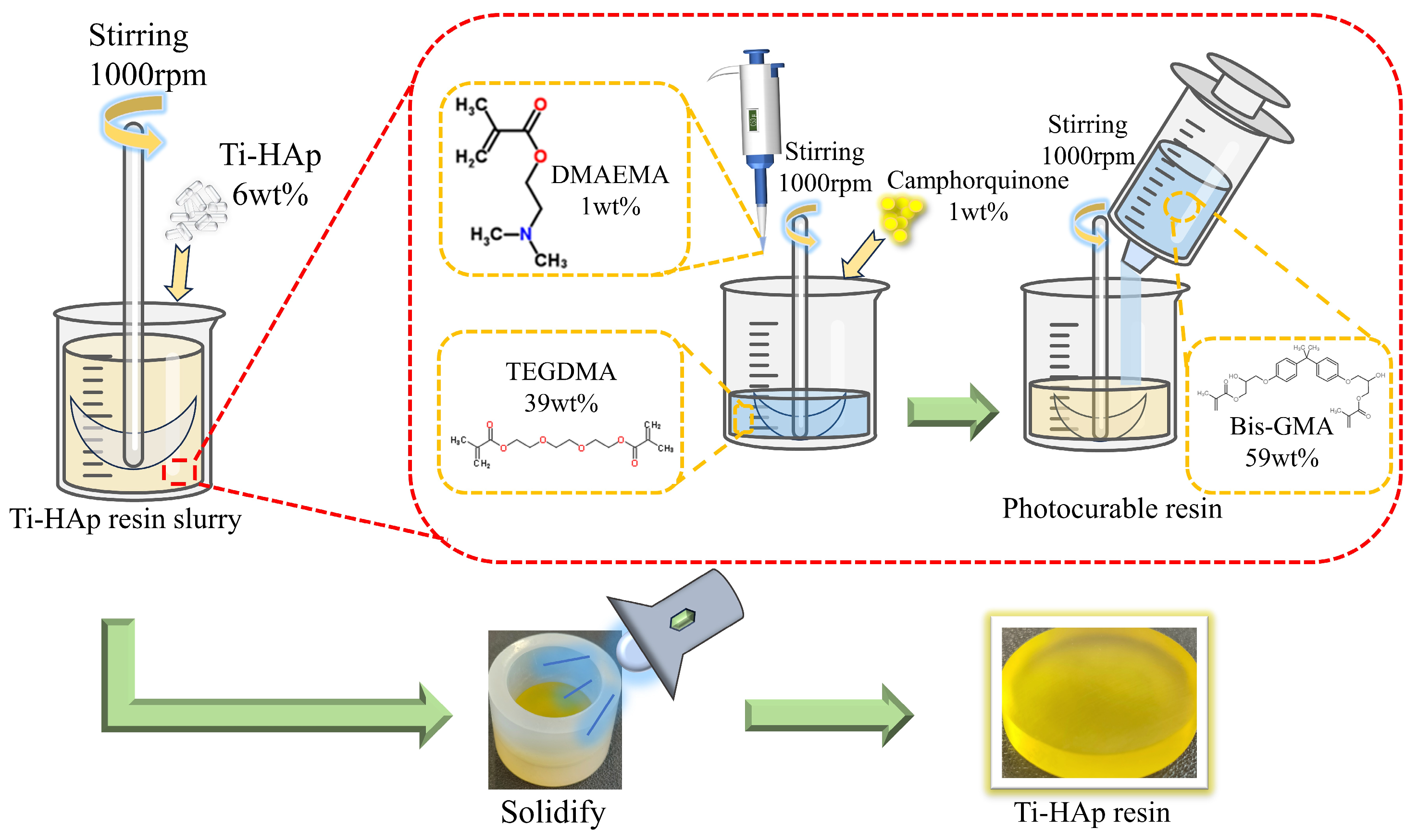
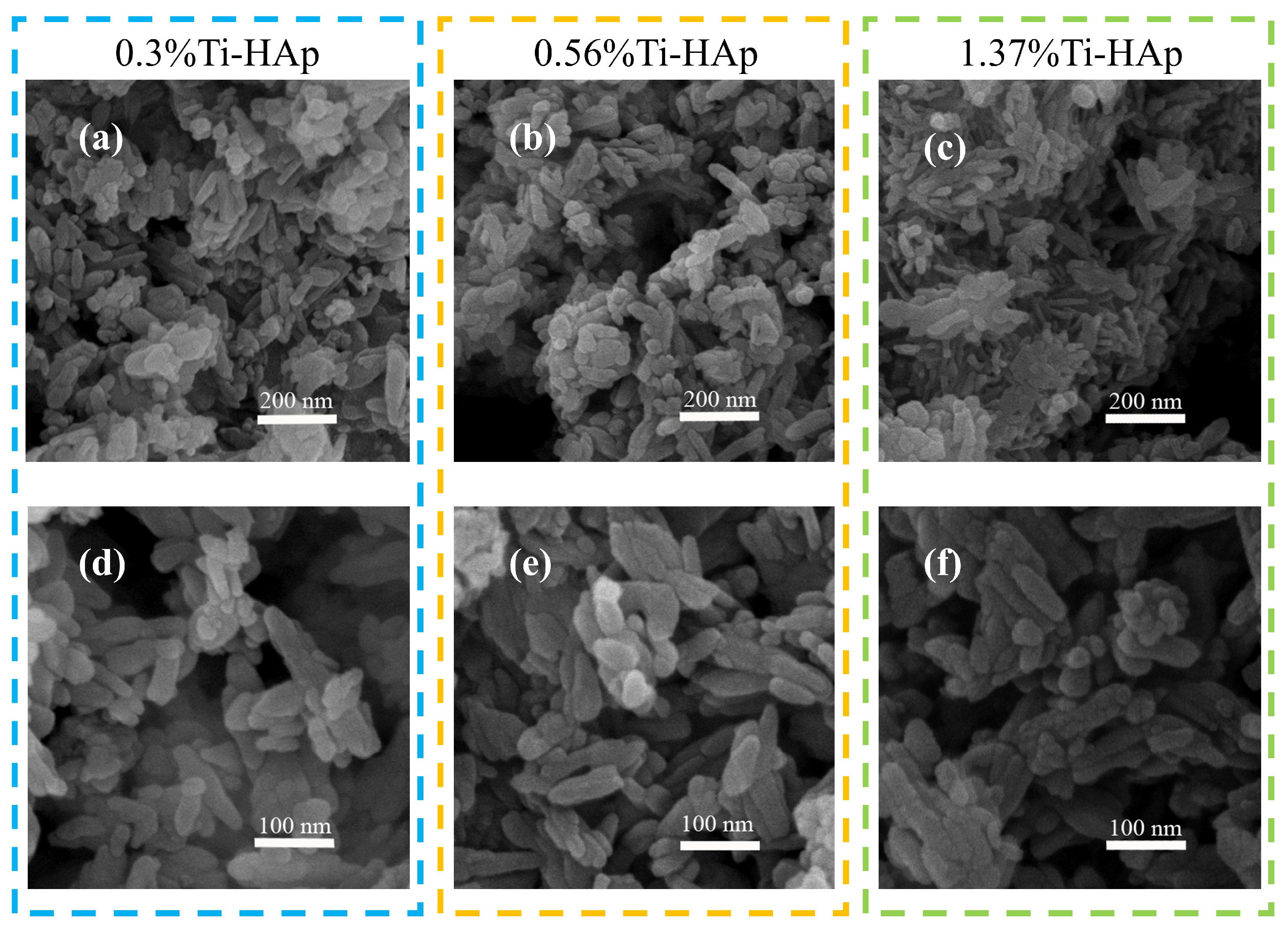
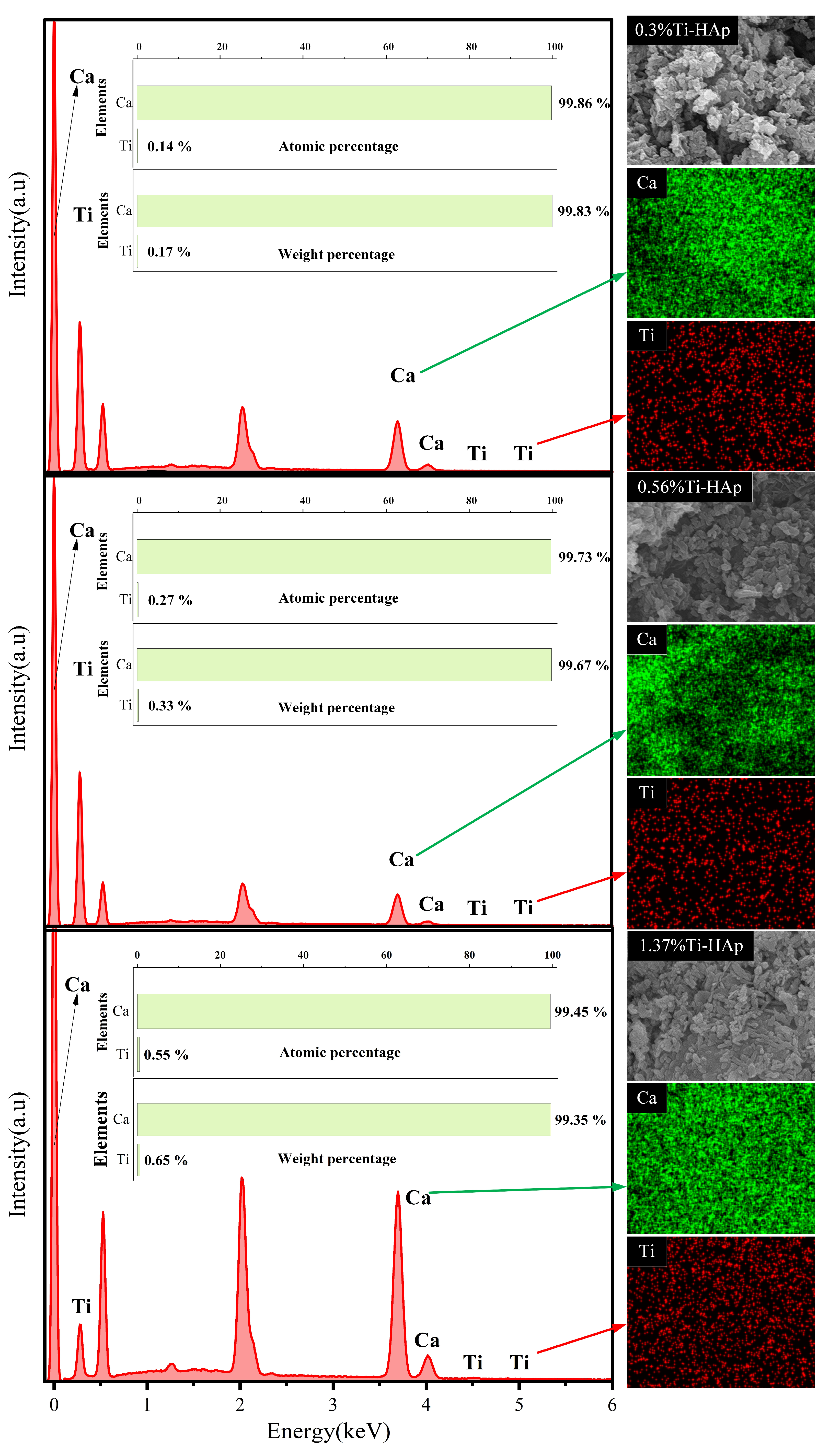
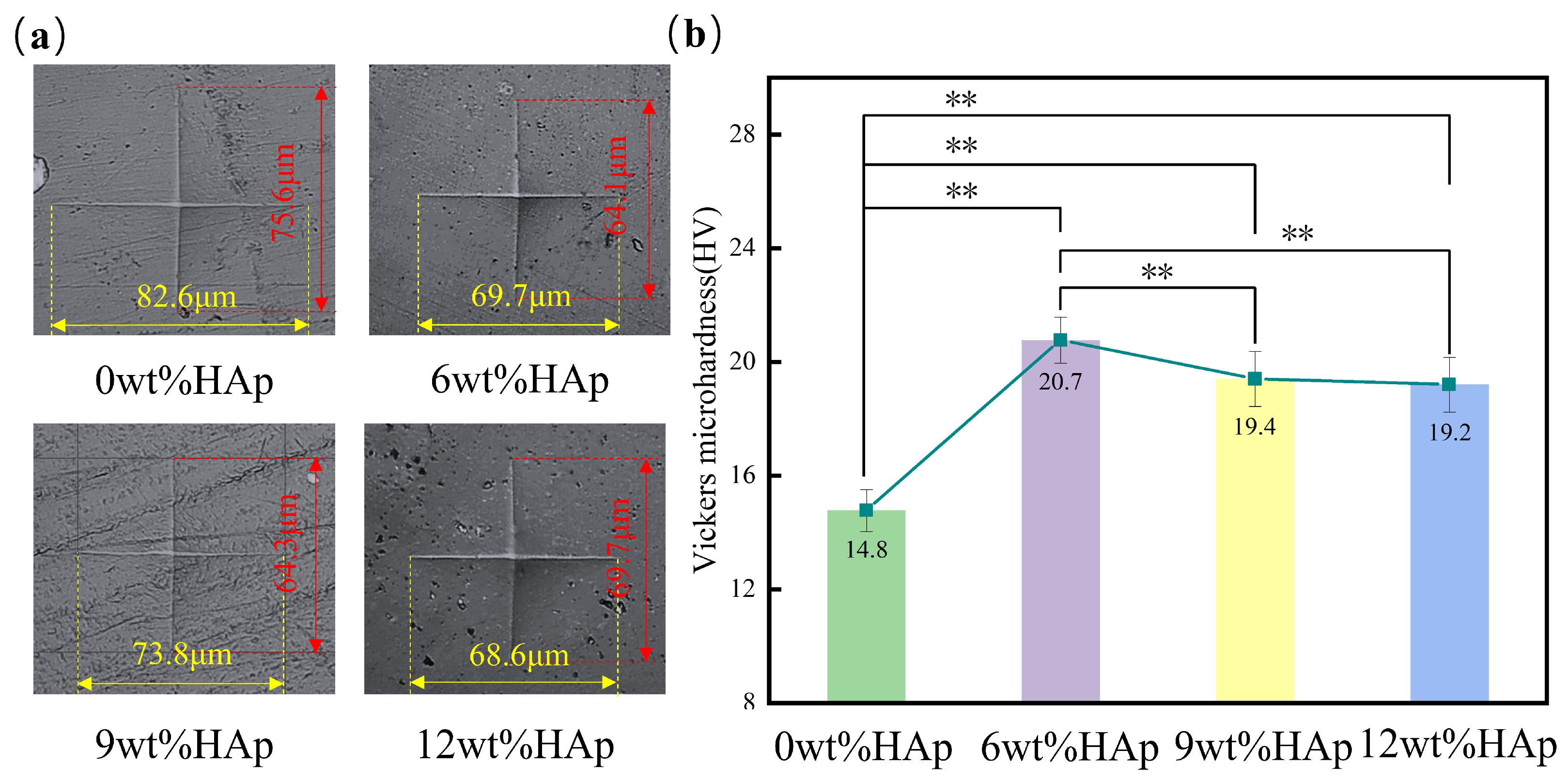

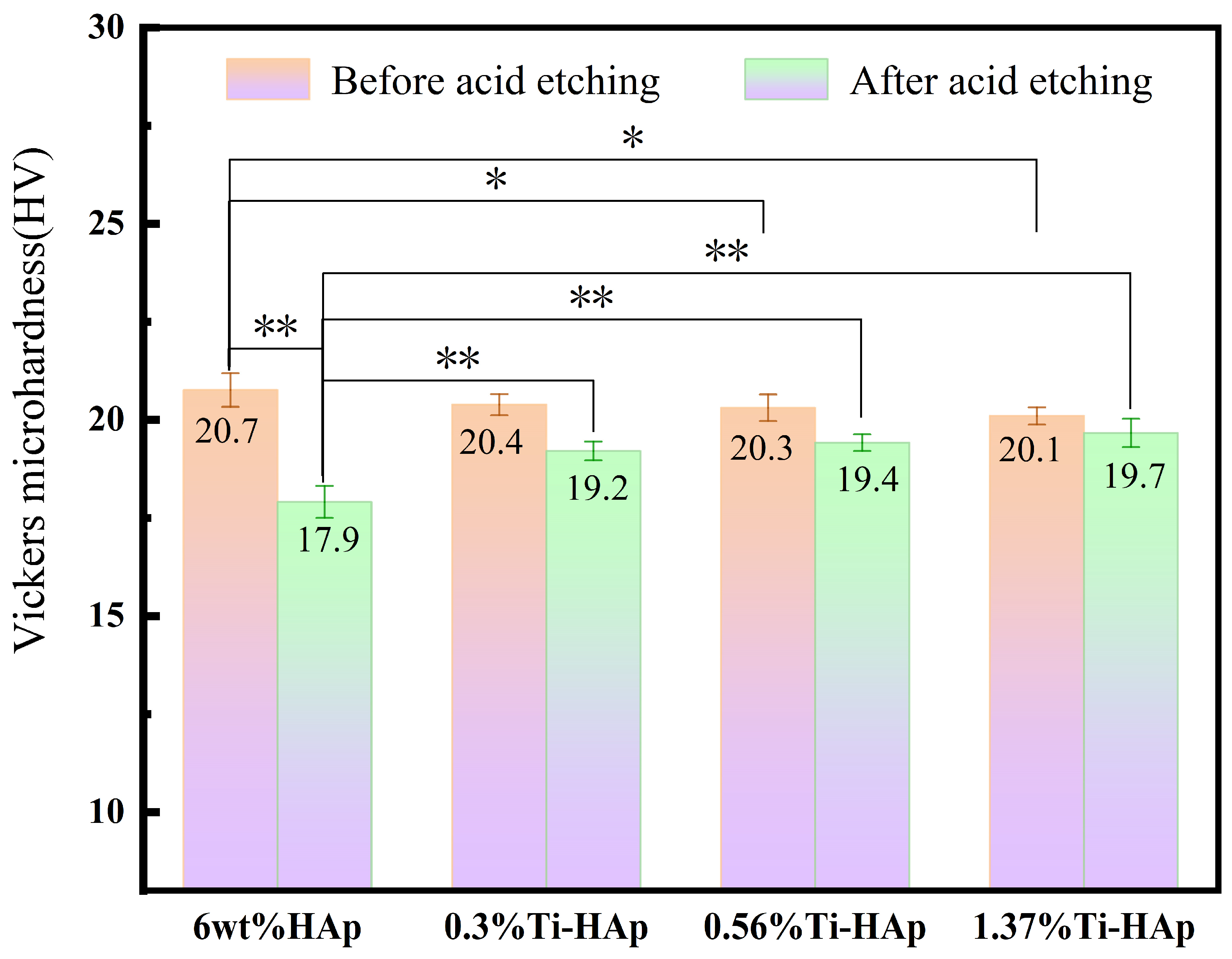
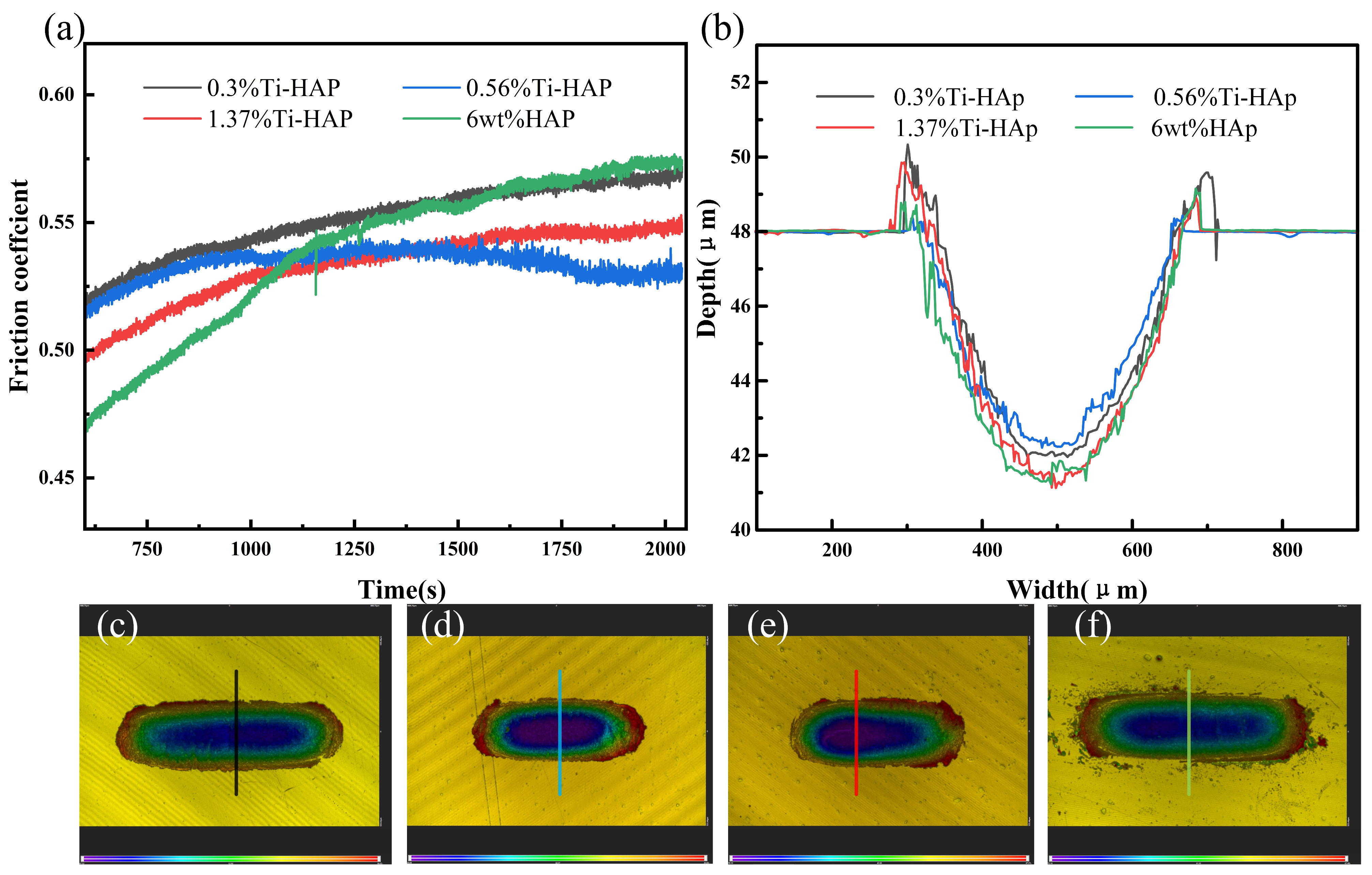
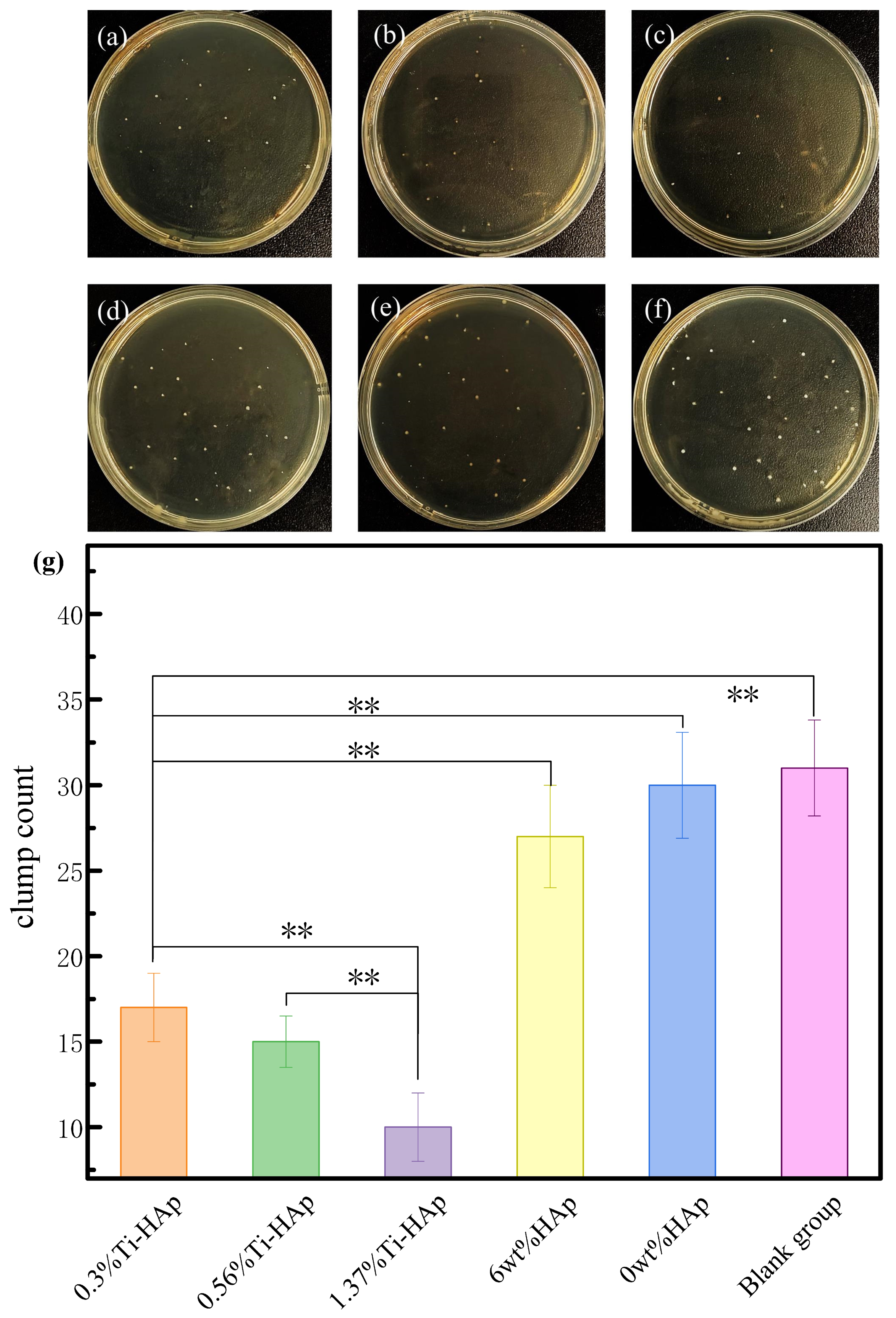

| Ti/Ca Molar Percentage | 1% | 2% | 3% |
|---|---|---|---|
| hydroxyapatite (HAp) | 5 g | 5 g | 5 g |
| titanium dioxide (TiO2) | 1.24 mL | 2.50 mL | 3.78 mL |
| deionized water (H2O) | 17.297 mL | 22.5 mL | 18.9 mL |
| Pilot Sample | 0wt%HAp | 6wt%HAp | 9wt%HAp | 12wt%HAp |
|---|---|---|---|---|
| HAp (g) | 0 | 0.6 | 0.9 | 1.2 |
| Bis-GMA (g) | 5.88 | 5.52 | 5.34 | 5.16 |
| TEGDMA (g) | 3.92 | 3.68 | 3.56 | 3.44 |
| Camphorquinone (CQ) (g) | 0.1 | 0.1 | 0.1 | 0.1 |
| DMAEMA (g) | 0.1 | 0.1 | 0.1 | 0.1 |
| Sample Number | Sampling Quality/g | Constant Volume/mL | Element | Results | ||
|---|---|---|---|---|---|---|
| Conversion Content | Unit | Mohr’s Percentage | ||||
| 0.3%Ti-HAp | 0.1025 | 20 | Ca | 375,616.98 (±1842) | mg/kg | 99.7 |
| 0.56%Ti-HAp | 0.1048 | 20 | Ca | 385,184.16 (±1764) | mg/kg | 99.44 |
| 1.37%Ti-HAp | 0.1028 | 20 | Ca | 382,608.37 (±1911) | mg/kg | 98.63 |
| 0.3%Ti-HAp | 0.1025 | 20 | Ti | 1426.15 (±6.2) | mg/kg | 0.30 |
| 0.56%Ti-HAp | 0.1048 | 20 | Ti | 2597.33 (±10.6) | mg/kg | 0.56 |
| 1.37%Ti-HAp | 0.1028 | 20 | Ti | 6418.29 (±17.4) | mg/kg | 1.37 |
Disclaimer/Publisher’s Note: The statements, opinions and data contained in all publications are solely those of the individual author(s) and contributor(s) and not of MDPI and/or the editor(s). MDPI and/or the editor(s) disclaim responsibility for any injury to people or property resulting from any ideas, methods, instructions or products referred to in the content. |
© 2024 by the authors. Licensee MDPI, Basel, Switzerland. This article is an open access article distributed under the terms and conditions of the Creative Commons Attribution (CC BY) license (https://creativecommons.org/licenses/by/4.0/).
Share and Cite
Li, X.; Yao, C.; Shen, J.; Zhu, S.; Kong, Y.; Yao, C.; Zhou, Y.; Xia, J. The Impact of Titanium Hydroxyapatite Doping on the Mechanical and Biological Properties of Photocured Resin. Micromachines 2024, 15, 1040. https://doi.org/10.3390/mi15081040
Li X, Yao C, Shen J, Zhu S, Kong Y, Yao C, Zhou Y, Xia J. The Impact of Titanium Hydroxyapatite Doping on the Mechanical and Biological Properties of Photocured Resin. Micromachines. 2024; 15(8):1040. https://doi.org/10.3390/mi15081040
Chicago/Turabian StyleLi, Xiaopan, Chao Yao, Junfu Shen, Siqi Zhu, Yiyun Kong, Chun Yao, Yuankai Zhou, and Jing Xia. 2024. "The Impact of Titanium Hydroxyapatite Doping on the Mechanical and Biological Properties of Photocured Resin" Micromachines 15, no. 8: 1040. https://doi.org/10.3390/mi15081040






